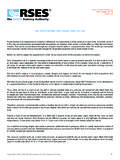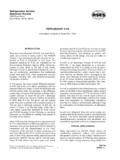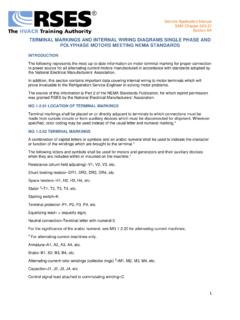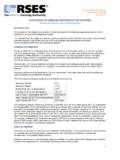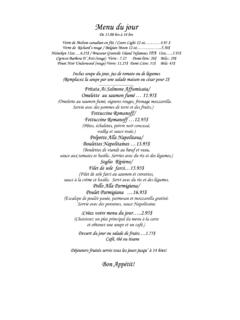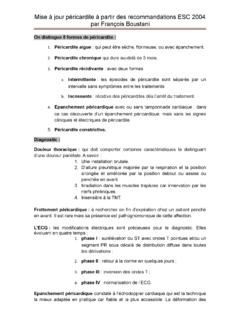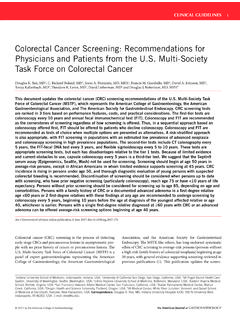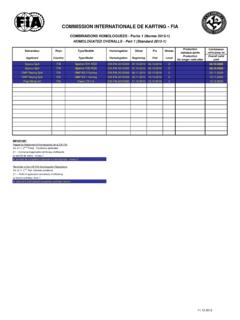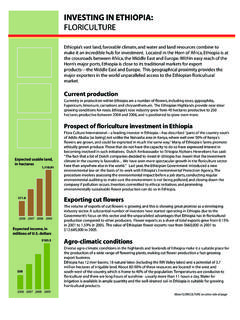Transcription of Understanding sUperHeat - RSES.org
1 B y A n d y S c h o e n , cMProperly calculating these measurements will greatly help to determine the efficiency or inefficiency of an hVAcR RSES Journal JUNE 2010w w w . r s e s j o u r n a l . c o m Image 1 This illustration is a basic example of the defini-tion of saturation temperature the temperature at which fluid boils. Image 2 The addition of heat to saturated steam (as il-lustrated above) superheats the steam s (and sU bcooling)[Editor s Note: For more information on test instruments that can be utilized to properly calculate sUperHeat , see What in the Truck Do HVACR Techs Carry on pg. 8. Readers also can use the information shown in the images to determine sUperHeat and subcooling measurements for R-134a and R-401A systems the answers for which can be found on pg.]
2 36.]When it comes to explaining the subject of sUperHeat , it is useful to begin with the most abundant fluid on our planet, refrigerant R-718 otherwise known as water. The illustration in Image 1 shows that water boils at 212 F (100 C); which is a principle that plays into the defini-tion of saturation temperature the temperature at which a fluid boils. A fluid at its saturation temperature can exist in two phas-es: as a liquid or vapor; or as a mixture of both. Liquid and vapor at its saturation temperature is referred to, respectively, as saturated liquid and saturated vapor. In the case of water, it exists at 212 F as liquid water; as a mixture of liquid and vapor (steam); or as a UpA tea kettle provides an excellent example of what happens when water is heated to its boiling temperature.
3 As water boils it converts to steam; the temperature of the steam leav-ing the kettle will not exceed its saturation temperature. However, if heat is added to the saturated steam (shown in Image 2), the steam s temperature rises and in the case of this illustration, superheats the temperature of the steam from 212 F to 232 amount of sUperHeat in a vapor is determined by sub-tracting the saturation temperature from the actual vapor temperature. For example, at a temperature of 232 F, the sU perHeatw w w . r s e s j o u r n a l . c o mJUNE 2010 RSES Journal 15 Image 3 Pressure applied toward a fluid will affect its saturation temper-ature a factor that can complicate determining sUperHeat . The saturation curve above shows how pressure impacts the boiling temperature of Reader Service No.
4 70steam s sUperHeat is calculated using this equation: 232 F 212 F = 20 complication with determining sUperHeat is the fact that the pressure exerted on the fluid influences its sat-uration temperature. Water boils at 212 F only at psia, which is the average atmospheric pressure at sea level. As pressure increases on water, or any other fluid for that matter, its saturation temperature increases. Con-versely, as pressure on a fluid decreases, its saturation temperature fact comes as no surprise to a resident in Denver, CO, who must boil their pasta longer to properly pre-pare it than an individual in Chicago, IL. In Denver, the average atmospheric pressure is psia, or psi below atmospheric pressure at sea level. At psia, water boils at only 203 F, which certainly slows down the cook-ing process.
5 This actuality brings up the impor-tance of the pressures and corresponding saturation temperatures for a fluid its saturation curve. This curve also is re-ferred to as the pressure-temperature or PT curve. A section of the satura-tion curve for water is shown in Image yoUr sUbcoolingProper Understanding of sUperHeat also requires an Understanding of subcooling. Water temperature that is below its saturation temperature and in its liquid state is in its subcooled state. So if the temperature of water in a cup of hot coffee is 172 F, what is its amount of subcooling, assuming an atmospheric pressure of psia?The amount of subcooling in a liq-uid is determined by subtracting the ac-tual liquid temperature from the satu-ration temperature.
6 For example, at a temperature of 172 F, the water is sub-cooled by 40 F (212 F 172 F = 40 F).This brings us to refrigerants. These fluids generally have much lower satu-w w w . r s e s j o u r n a l . c o m16 RSES Journal JUNE 2010ration temperatures than water, and provide operating pres-sures desirable for compressor is it necessary to understand sUperHeat and subcool-ing with a refrigeration system? Because as refrigerant circu-lates around the system, it becomes subcooled, saturated and superheated. The ability to measure sUperHeat and subcool-ing will determine if the system is operating properly. A ba-sic refrigeration system consisting of a compressor, condens-er, receiver, TXV and evaporator is shown in Image the system is operating properly, the high side of the sys-tem (from the compressor to the TXV) will contain refriger-ant in all three states: subcooled, saturated and superheated.
7 The discharge line contains high-pressure superheated vapor. As the refrigerant vapor flows through the condenser, its tem-perature is reduced and condenses into a liquid-vapor mixture, and finally to a liquid that normally has a small amount of low side of the system (from the TXV to the compres-sor) normally contains refrigerant in two of the three states: saturated and superheated. The refrigerant flows into the evap-orator as a liquid-vapor mixture, where it evaporates into a su-perheated vapor before entering the addition to the condenser and evaporator, the techni-cian will find refrigerant at saturation in the receiver. Due to the fact that there is potential to have subcooled refriger-ant entering and leaving the receiver, the tech can expect both subcooled and saturated refrigerant at the liquid-vapor interface in the to Image 4 again, pressure and temperature mea-surements are shown at various locations in the system, with R-134a as the refrigerant.
8 Image 5 on pg. 17 lists pressure-tem-perature values for R-134a, which are used to determine the amount of subcooling or sUperHeat present at each location. As an exercise, use the temperatures specified for R-134a where two temperatures are listed to determine the proper sUperHeat and subcooling values. The answers to these ques-tions are provided in RSES News on pg. blendsRefrigerant blends combine more than one refrigerant to achieve desired properties. They have become prevalent dur-ing the past 20 years due to efforts to eliminate the use of CFC and HCFC refrigerants, and the need to match them with suitable alternatives. Popular refrigerant blends carry an ASHRAE 400 or 500 series refrigerant blends can be categorized into two groups: azeotropes and non-azeotropes.
9 Azeotropes behave like single-constituent refrigerants, and the procedures discussed above to measure sUperHeat and subcooling , however, present an interesting issue with respect to sUperHeat and subcooling measurements. Unlike azeotropes and single-constituent refrigerants, non-azeotropes do not have a constant saturation temperature at a given that a fluid at its saturation temperature can exist in two phases: as a liquid or vapor; or as a mixture of both. In the case of a non-azeotrope refrigerant blend, the satura-tion temperature rises as it moves from a saturated liquid to a liquid-vapor mixture and, finally, to a saturated temperature at which the refrigerant blend begins to boil is the saturated liquid temperature, or bubble point; and the temperature at which the refrigerant begins to con-dense is the saturated vapor temperature, or dew point.
10 The difference between dew-point and bubble-point temperatures is often referred to as temperature calculate sUperHeat with a non-azeotrope refrigerant, use the dew-point temperature:Actual vapor temperature dew-point temperature = calculate subcooling with a non-azeotrope refrigerant, use the bubble-point temperature:Bubble-point temperature actual liquid temperature = , a non-azeotropic refrigerant blend, was designed as a substitute for R-12. Bubble- and dew-point temperatures Image 4 This illus-tration shows all the basic components of a refrigeration system. Readers can use the correspond-ing information and temperature readings (as well as the information included in the chart on the following page) to calculate various sUperHeat /subcooling values.

